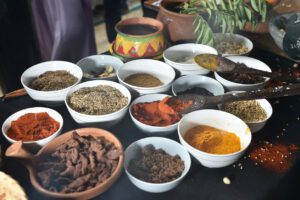Pandi curry, a traditional delicacy from the indigenous Kodava community of Coorg, offers a blend of tradition and flavour with every bite.

The uniqueness of pandi curry is in its preparation. (Sheraton Chennai)
While filming his Uncharted food series for National Geographic in Madikeri, celebrity chef Gordon Ramsay couldn’t stop gushing over the beautiful locales of Coorg.
More importantly, he was effusive about pandi curry — Coorgi pork curry. This pork curry highlights how this region has been the world’s leading exporter of spices for over 3,000 years, especially peppercorns and cardamom.
Nestled in the lap of lush mountains and rich heritage, Coorg, also known as Kodagu, stands out as a land of distinctive flavours and culinary traditions.
At the heart of its intriguing cuisine lies the beloved and signature dish of the region — pandi curry. The pork-based delight has become a source of local pride and a must-try for food enthusiasts.
To truly grasp the essence of pandi curry, one must travel back in time. The indigenous community of Coorg, also known as the Kodavas, developed a unique affinity for pork.

Gobu Kumar, Executive Chef, Crowne Plaza Chennai Adyar Park. (Supplied)
Unlike many parts of Southern India, where chicken or fish dominate the culinary landscape, Coorg’s fondness for pork has deep historical and cultural roots.
Gobu Kumar, executive chef at Crowne Plaza Chennai Adyar Park, explains that pork was considered a delectable food in Kodagu due to its high fat and robust content.
The Kodavas’ connection with hogs extended beyond the kitchen.
Hogs played a crucial role in agricultural activities, aiding in ploughing fields and providing traction. Over time, this association translated into their culinary tradition as well.
When hunting was prohibited, domesticated hogs became a sustainable source of pork, solidifying its place as a staple in the local diet.
“Coorg was inaccessible and unapproachable by outsiders for a long time, so the Coorgis started using local spices to their advantage. The authentic preparation method along with the usage of local spices made pandi curry a signature dish,” he elaborates.
But what sets pandi curry apart? Jerson Fernandes, culinary director at Novotel Mumbai Juhu Beach, notes that the uniqueness is in its preparation.

Chef Jerson Fernandes. (Supplied)
“The slow cooking of tender pork cubes seasoned with the pepperiness of kachampuli has made the dish distinctive. To relish the delectable pork preparation, I would insist that it be served with kadambuttu (steamed rice balls) or akki otti (flat rice bread),” he emphasises.
That said, cooking pandi curry is not meant for everyone.
The traditional method requires a two-day marination process, allowing the pork to absorb all the flavours. Moreover, using coarsely ground spices adds texture and depth to the dish.
This spice blend, combined with the pork’s succulence, creates a harmonious taste.
But what truly gives pandi curry its tangy twist is the kachampuli. This souring agent is unique to Coorg and lends a spicy and rich flavour profile to the curry. Its piquant presence, akin to balsamic vinegar, elevates the dish to new heights.
What distinguishes pandi curry from other pork preparations in the southern states, such as Kerala and Goa, is its distinct Coorg identity.

Dry roasting of spices for the gravy. (Supplied)
Hailing from Coorg, Gaurav Ganapathy, director of sales and marketing at Sheraton Grand Chennai Resort & Spa Mahabalipuram, says, “The use of coarsely ground spices, marination process, incorporation of kachampuli vinegar, and unique accompaniments like kokum showcase a flavour profile deeply rooted in Coorg’s cultural heritage, offering a taste that’s both distinct and emblematic of the region.”
In addition to kachampuli, the dry roasting of spices like coriander seeds, mustard seeds, black peppercorns, and fenugreek also adds to the curry’s distinctive taste.
The key to the perfect pandi curry, however, lies in selecting the right pork, preferably boneless meat like belly or shoulder cuts, with a generous amount of fat.
When cut into 1 to 2-inch pieces, it becomes perfect for absorbing the semi-gravy spiciness and sourness of the curry.
Can pandi curry maintain its distinctive taste without the revered kachampuli vinegar and specific spice mix?

The key to the perfect pandi curry lies in selecting the right pork. (Jerson Fernandes)
While there’s no perfect substitute for these unique ingredients, alternatives can still bring out the dish’s essence. Thick tamarind juice or tamarind pulp and vinegar blend can mimic the kachampuli’s tanginess.
As for the coarsely ground spices, a combination of readily available ground spices can replicate the overall flavour profile.
Gaurav states, “As for spices, while the exact coarseness may be challenging to replicate, using a combination of ground spices like turmeric, red chili, coriander, and cumin can help achieve a similar flavour profile. While these substitutes may not be exact replicas, they can still result in a flavourful dish reminiscent of pandi curry’s unique taste.”
Pandi curry isn’t just a dish; it’s a testament to Coorg’s history, culture, and culinary expertise. Every bite offers a symphony of flavours. Whether you’re an avid foodie or a curious traveller, pandi curry promises an adventure for your taste buds deeply rooted in tradition and delightfully unique to Coorg.
INGREDIENTS
For the marinade

Using coarsely ground spices adds texture and depth to the dish. (iStock)
For the curry
METHOD
(Recipe by Jerson Fernandes, director of culinary, Novotel Mumbai Juhu Beach)

May 21, 2024

May 21, 2024

May 21, 2024

May 21, 2024

May 21, 2024

May 20, 2024